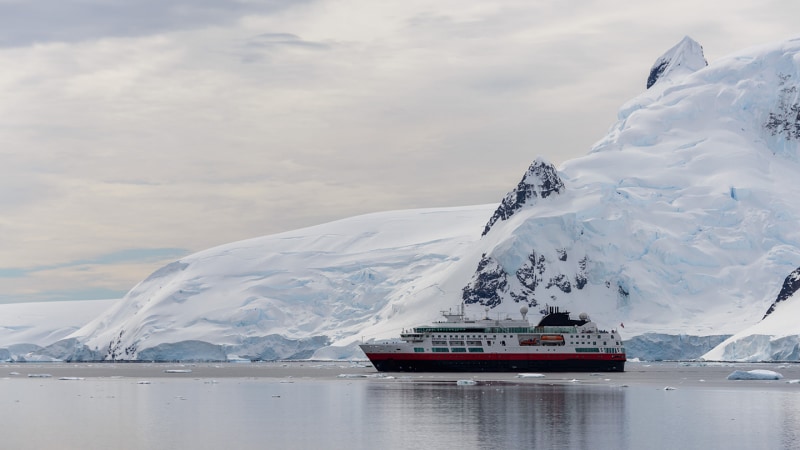Guide to cruising to Antarctica

Quick insights
- Antarctica cruises provide a unique experience that can include hiking glaciers, watching whales and experiencing the “Midnight Sun” phenomenon.
- The best time to cruise to Antarctica is during its summer months, from November to March.
- Cruises to Antarctica can sell out months, or sometimes, even years in advance.
Antarctica was virtually unexplored until the early 1900s. Today, there are many expedition operators that set sail to Antartica, letting passengers take in the sights of mountainous glaciers, breaching humpback whales and endless daylight.
Read on if you’re thinking of cruising to Antarctica and want to know the best times to go, potential itineraries and what to expect when embarking on this potentially once-in-a-lifetime trip.
Introduction to cruising Antarctica
There is no place on Earth quite like Antarctica. Its harsh conditions and pristine beauty are sure to provide a unique cruising experience. Its growing popularity as a cruise destination also means you’ll have options when it comes to planning your perfect Antarctica cruise.
When deciding, you may want to consider the size of the ship and level of luxury you want. You can sail to Antarctica on a very basic ship or an ultra-luxe voyage with white table clothes and spa services. Cruises to Antarctica usually last anywhere from 6 to 17 days and typically cost upwards of $5,000 per person.
You may want to consider booking a cruise to Antarctica at least 8 months in advance, although a year out can be ideal. Access to Antarctica is limited to help mitigate the effects of tourism on the environment, so ships can sell out months or even years ahead.
Ship size can vary from smaller ships with less than 100 passengers to larger ships with 500+ passengers. However, ships carrying more than 500 passengers are prohibited from letting their passengers ashore.
The best time to cruise to Antarctica
The best time to cruise to Antarctica is from November to March—which is summer on the South Pole. But even with summer temps, you may only see highs just above freezing.
Late December through January is considered peak time. You’ll experience the warmest weather and have a chance of spotting massive icebergs. You also can experience 24 hours of daylight during this time of year and may see hordes of newly hatched baby penguin chicks scurrying across the frozen tundra.
If you sail a month earlier—between November and early December—you'll likely see penguins building their nests in preparation for their chicks and baby seals who are still being weaned by their mothers. This time of year also tends to feature a thick blanket of snow on the ground, which may be appealing if you're hoping to cross-country ski or snowshoe.
Whale watching is at its peak during the end of summer in Antarctica. March is a great time of year to see migrating whales, but there may be less snow and ice than during the earlier summer months.
Antarctica cruise routes
Ships sailing to Antarctica typically depart from one of three ports in South America:
- Ushuaia, Argentina
- Punta Arenas, Chile
- Puerto William, Chile
No matter which port you sail from, your ship will have to pass through the infamous Drake Passage. This notoriously rough patch of sea is located between South America's Cape Horn and the South Shetland Islands of Antarctica. The Drake Passage’s powerful unimpeded current has earned it the unofficial designation of the world’s most terrifying ocean crossing.
You can skip the Drake Passage with an Antarctic fly and cruise trip. These trips offer a two-hour flight from Punta Arenas, Chile or nearby Puerto Natales to King George Island in the South Shetland Islands of Antartica. From there, you can board a ship and sail through Antarctica.
Planning your itinerary
While cruising around Antarctica, you may be able to kayak among glaciers, see wildlife like penguins and seals up close or visit a scientific station.
Many ships will drop anchor and take passengers to land on smaller ships called Zodiacs for land exploration. Depending on the time of year and snow conditions, you also may be able to snowshoe, ski or hike glaciers.
Common regions to explore on an Antarctica cruise include:
- Antarctic Peninsula: One of the most visited regions in Antarctica that includes the Lemaire Channel, Deception Island and Half Moon Island.
- Weddell Sea: Known for its diverse wildlife, Weddell Sea is off the eastern coast of the Antarctic Peninsula.
- South Shetland Islands: This archipelago on the north end of the Antarctic Peninsula includes Deception Island and Elephant Island, made famous by explorer Ernst Shackleton's expedition in the early 1900s.
Longer Antarctica cruises often include stops in the Falkland Islands and South Georgia and the South Sandwich Islands. These islands are in the Atlantic Ocean—north of Antarctica and east of South America—and provide more opportunities to see wildlife and natural beauty.
Preparing for an Antarctica cruise
Due to the remote and extreme nature of Antarctica, you may want to plan for this trip differently than you would like other cruises.
Essential documents
You will need a valid passport to sail to Antarctica. Even though Antarctica doesn’t belong to any one nation, you will typically need to pass through Chile, Argentina, New Zealand or South Africa to get to this remote continent.
Packing
When packing for the extreme weather and rugged terrain of Antarctica, you may want to bring layered clothing like long thermal underwear, wool socks and waterproof ski gloves or mittens with handwarmers.
However, heavy winter coats and boots may not be necessary. Many Antarctica expedition companies supply windproof jackets and tall rubber boots. Check with your cruise operator to confirm what outerwear may be provided.
Baggage weight limits
If you travel to Antarctica via charter flight, you may need to follow stricter weight restrictions for baggage. Checking luggage weight limits prior to your trip can help you plan what to pack.
In summary
Antarctica isn’t always at the top of everyone’s travel bucket list. It takes time, money and an adventurous spirit to travel to this icy wilderness. But the uniqueness of seeing and stepping foot on Antarctica makes it a draw for many travelers.
As the popularity of Antarctica cruises grows, so does the impact of cruising on the environment. Antarctica’s only permanent residents are its wildlife. To preserve their habitats, cruise operators need to follow regulations to minimize their impact. Many also offer programming on board meant to reinforce the fragility of this continent while also fostering a sense of responsibility to the region and climate.



